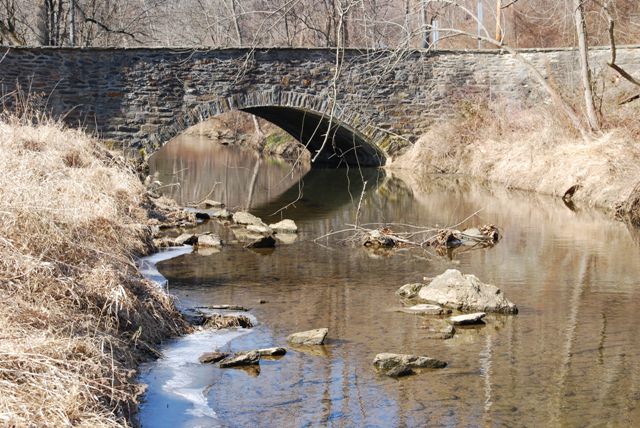We Recommend:
Bach Steel - Experts at historic truss bridge restoration.
Denton Hollow Road Bridge

Primary Photographer(s): Elaine Deutsch
Bridge Documented: 2008
Rural: Chester County, Pennsylvania: United States
1914 By Builder/Contractor: George Dole of Wilmington, Delaware and Engineer/Design: Nathan R. Rambo
Not Available or Not Applicable
30.0 Feet (9.1 Meters)
37.0 Feet (11.3 Meters)
18 Feet (5.49 Meters)
1 Main Span(s) and 1 Approach Span(s)
15701504380249

View Information About HSR Ratings
Bridge Documentation
View Archived National Bridge Inventory Report - Has Additional Details and Evaluation
This stone arch bridge is a good example of a traditional stone arch, however it also has a six foot concrete slab approach span. This span appears to be original. In 1914, concrete was already becoming common in bridge construction. Chester County only continued to use the 19th Century technology of stone arch bridges because Nathan Rambo, the county engineer preferred the material. Stone is a durable material, and the fact that his family had been in the stone quarry business may have influenced his choice of bridge material.
Information and Findings From Pennsylvania's Historic Bridge InventoryDiscussion of Bridge The one-span, 31'-long stone arch bridge, built in 1914, has voussoirs, fieldstone spandrel walls, and stone parapets. It is supported on stone abutments. The intrados is pargetted. At the south end of the bridge is an approximately 6'-long, reinforced concrete slab overflow span with pipe railings. (The slab span is contiguous to the arch, but not counted as part of the BMS record for purposes of no. of spans or span length.) The stone arch bridge is a short and undistinguished example of a bridge type that is common from the first two decades of the 20th century in Chester County. The county-built traditional stone arch bridges were favored by the county engineer, and at least 19 similar bridges from 1908 to 1919 have been identified. Stone arch bridges have been in use in Pennsylvania since the late 17th century, and over 350 examples have been identified statewide, with more than two thirds dating to before 1900. Early 20th century examples in Chester County are considered individually significant in the local context only when they are complete and large or particularly well detailed. This example is not historically or technologically distinguished within its population or by its setting and context. Discussion of Surrounding Area The bridge carries a 2 lane road over a stream in a rural setting with scattered residences. Northwest of the bridge is a new housing subdivision. At the northeast quadrant is a wooded lot with an unused grain silo. At the southwest quadrant is a vernacular stone residence (ca. 1800) on a wooded lot. To the southeast quadrant is an open field. The setting does not have the cohesiveness or integrity of resources to merit rural historic district potential. Bridge Considered Historic By Survey: No Information and Findings From Pennsylvania's Stone Arch Bridge Management PlanDiscussion of Bridge This bridge is a candidate for long-term preservation. It is ranked within the highest third of all stone arch bridges under study in this plan. It ranks high or very high in three categories. It has a high condition code and needs to have no specific action. It has historic integrity, a result of the bridge's historic fabric being largely intact; therefore, it would be relatively inexpensive to rehabilitate. The bridge contributes to a potential local historic district and is part of a greenway, resulting in a very high values code, although It has received little public support (one questionnaire). The transportation code ranks just below high, a result of low traffic volumes and reasonable sight distance at its approaches. The current low traffic volume should offset a moderate development code; however, the development will likely result in a modest increase in traffic in the future. The bridge's waterway is adequate. Ratings The Pocopson, Denton Hollow Road Bridge is owned by
Chester County and is ranked 34th. Recommendation: A strong candidate for long-term preservation. |
![]()
Photo Galleries and Videos: Denton Hollow Road Bridge
Bridge Photo-Documentation
Original / Full Size PhotosA collection of overview and detail photos. This gallery offers photos in the highest available resolution and file size in a touch-friendly popup viewer.
Alternatively, Browse Without Using Viewer
![]()
Bridge Photo-Documentation
Mobile Optimized PhotosA collection of overview and detail photos. This gallery features data-friendly, fast-loading photos in a touch-friendly popup viewer.
Alternatively, Browse Without Using Viewer
![]()
Maps and Links: Denton Hollow Road Bridge
Coordinates (Latitude, Longitude):
Search For Additional Bridge Listings:
Bridgehunter.com: View listed bridges within 0.5 miles (0.8 kilometers) of this bridge.
Bridgehunter.com: View listed bridges within 10 miles (16 kilometers) of this bridge.
Additional Maps:
Google Streetview (If Available)
GeoHack (Additional Links and Coordinates)
Apple Maps (Via DuckDuckGo Search)
Apple Maps (Apple devices only)
Android: Open Location In Your Map or GPS App
Flickr Gallery (Find Nearby Photos)
Wikimedia Commons (Find Nearby Photos)
Directions Via Sygic For Android
Directions Via Sygic For iOS and Android Dolphin Browser
USGS National Map (United States Only)
Historical USGS Topo Maps (United States Only)
Historic Aerials (United States Only)
CalTopo Maps (United States Only)

